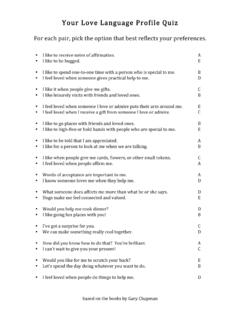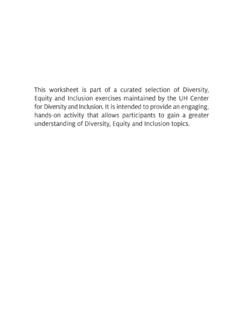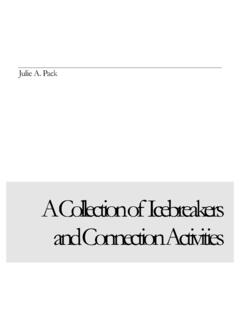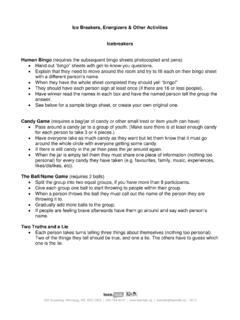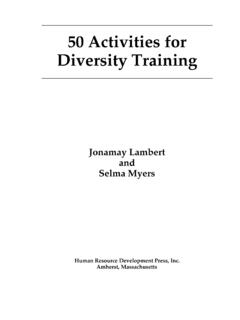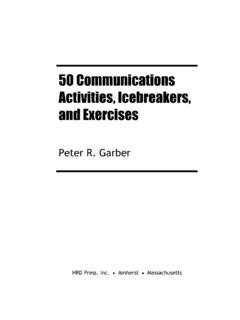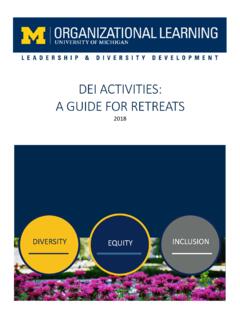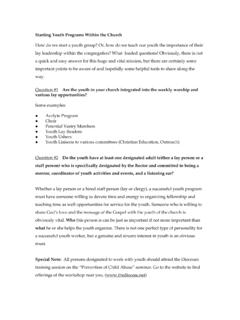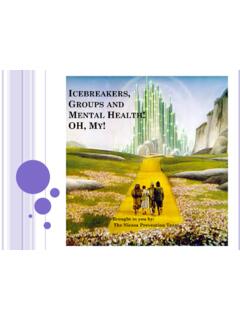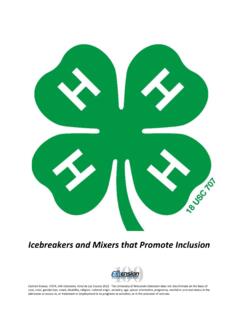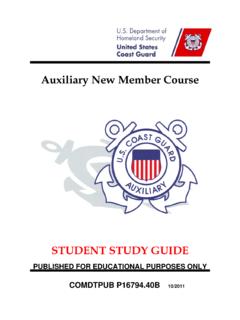Transcription of Diversity Based Teambuilders and Icebreakers from ...
1 PRACTICING INCLUSION: Icebreakers and Team builders for Diversity The Office of Intercultural Affairs Stonehill College When we do not actively include, we actively exclude. L. Talusan What does it mean to actively exclude? For years, I have worked with professionals and students to talk about how our very first activities usually in the form of Icebreakers and team builders send a message about who does and does not belong in our group. Many of us see our roles as building community; yet, we sometimes facilitate activities that marginalize others. Let s change that. Let s challenge ourselves to do better, think harder, and work to actively include the many experiences and identities that come to our groups. When folks struggle with an activity that does not actively include many experiences, identities, and abilities that participants bring to the session, the facilitator s reaction might be to say, Well, let s just not do that activity.
2 Let s just find another one. Or, worse, That person can just sit this one out. But, that s the easy way out. Why not find a way to practice inclusion by changing, adapting, or modifying the activity? Too tough? Well, we are here to provide some help! Why did we put this book together? The idea for this compilation grew out of the frustration of seeing many staffs, trainers and facilitators use Icebreakers and team builders that functionally excluded participants rather than included participants. Though done with good intentions, some popular activities created situations where individuals in a group were not able to participate ( , mobility issues, religious practices, etc.), felt uncomfortable participating ( , a high risk activity with little guidance, etc.), or created conditions where the activity could be interpreted as offensive ( , temporary disability, etc.)
3 Unfortunately, because there are only a few resources that compile good, solid, inclusive activities , many people simply took what was given to them. We seek to change that! This book is a collection of activities that we have gathered together from nearly two decades of experience in residence life, student affairs, K-12 education, workshop facilitations, trainings, and general sharing. The activities we have included have foundations in activities we have facilitated or participated in over the years, with our own special twist. We made them inclusive, made them relevant and made them accessible. Disclaimer Though some of the activities included here are originals, they are only as original as we claim them to be. I m sure that somewhere out there, someone has done them or a version of them.
4 Our intent was never to claim them all as our own or as entirely original. We are thankful to have worked with such amazing and talented professionals over the years. So, if an activity sounds familiar in here, we thank you! How to use this book This book was created with many different audiences in mind. It s perfect for staff development, team builders, as a class hook , or simple meeting starters. We also believe that engaged facilitation is 99% of the activity good facilitators know how to read their audience, adapt to the needs of participants, and seek to be inclusive. If you have any questions about the facilitation of these activities , please feel free to contact us at for some helpful hints! PLEASE NOTE: Within this book are activities that use certain language, scenarios, and situations that might trigger participants and facilitators.
5 Because our discussions are meant to name, own and interrupt conditions of oppression and invisibility, we use terms and scenarios in certain situations that are sensitive to some. It is incredibly important the facilitation is done responsibly and with great care for all involved. This book was made possible by the early work of Randall Phyall (former Coordinator of Intercultural Affairs), Justin Casey (volunteer/graduate intern for Intercultural Affairs), and the many friends we have made along the way in our careers. A very special thank you goes to Julie Kelly (Stonehill Class of 2013, Student Government Executive Diversity Chair, ALANA-A Brothers and Sisters Co-Coordinator, Resident Assistant, Intern for Intercultural Affairs, etc., etc., etc.) who took this book to a whole new level.
6 I am very grateful for your work and your leadership. Thank you to Fr. John Denning, , Vice President for Student Affairs, for his continued support of creating a diverse and inclusive environment at Stonehill College, particularly within the division of Student Affairs. I am grateful for your leadership. Liza A. Talusan, Director of Intercultural Affairs Stonehill College, July 20, 2012 PS: Share your versions, adaptations and modifications to these activities ! Email and we ll include it on our website! In the summer of 2012, I was hired as an Intern to the Director in the Office of Intercultural Affairs at Stonehill College, and was given the task of editing and compiling Icebreakers and other activities aimed at introducing Diversity , inclusion and reflection to group trainings, workshops and dialogues.
7 As a first-generation college student, I have had the privilege of being drawn into the Diversity conversation at Stonehill thanks to the comprehensive programming through the Office of Intercultural Affairs. It was challenging at first, and I m pretty sure I even cried at my first training session. However, I persisted and have developed a real sense of identity and passion for this work. Undergraduate students I have met and worked with do not always come to college with the same interest, passion and dedication to social justice. I knew that college was my opportunity to learn about different ways of being, knowing, and thinking, and through self-directed determination, I have taken advantage of opportunities to learn and grow as an ally. Why is this book important? As an undergraduate student involved with several Diversity initiatives and organizations, I ve realized just how difficult it can be to find go-to Icebreakers and activities for workshops that are accessible to participants of all backgrounds, experiences, and beliefs.
8 This book seeks to make introducing the Diversity conversation less complicated for the facilitator and engaging for the participant. It has been a privilege and honor to work on this publication, and I look forward to working with other allies in social justice! --- Julie Kelly, Stonehill College, Class of 2013 A FEW SUGGESTIONS FOR MODIFICATIONS: We seek to create the most inclusive environment for training sessions and workshops. While we may never create the perfectly inclusive activity every single time, we must strive to identify the ways we are practicing inclusion in activities and seek to create an overall training session that includes everyone. Here are some quick suggestions for modifications. This list is not comprehensive but rather provides a starting point.
9 Please work with your participants for suggestions, conduct additional research, or ask your Office of Disabilities Services, Multicultural Affairs, Health Services or other professionals for specific modifications. Physical Mobility: if your activity requires participants to move around freely, you might modify the activity by providing writing utensils, having participants raise their hands (depending on upper body mobility) rather than move around the room, or give verbal answers Visual needs: provide handouts in large print if needed, limit mobility of group if needed (see physical mobility modifications), or provide handouts with Braille if possible Auditory needs: provide written material in advance, limit extra room noise (some activities involve loud room noises with conversation, limit this by spreading out further or breaking into smaller groups), use microphone system when possible Dietary needs.
10 None of our activities include the use of food, however you should always find out if your participants have allergies (nut, latex, etc.). You should also be aware of dietary needs for meals (vegetarian, vegan, lactose, etc.) as well as religious needs (times of fasting, dietary restrictions for religious practice, etc.). Language needs: provide handouts that reflect the language needs of your group, the pace at which you give directions, the use of slang terms that limit translation and comprehension Inclusion of diverse structures: be aware of language that excludes others. For example, Instead of saying also include House house/apartment/where you call home Mom and Dad parents/guardians/those who cared for you Car car/bus/train/means of transportation God God/Gods/something that guides your morals PRACTICING INCLUSION: Icebreakers and Team builders for Diversity WHAT I WANT YOU TO KNOW The Purpose of This Activity This activity will allow participants to introduce themselves by giving them the opportunity to declare who they are and what they need from the group.

